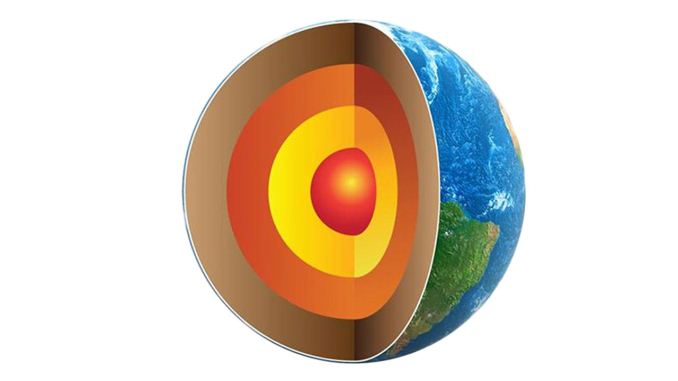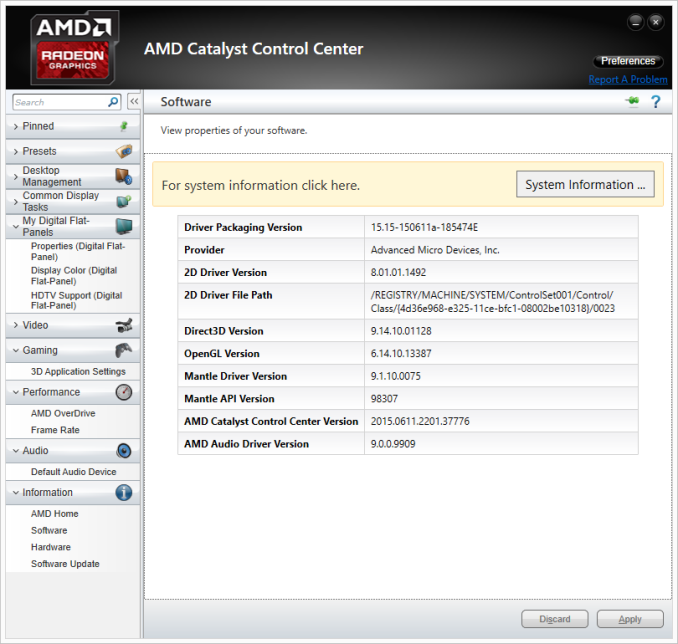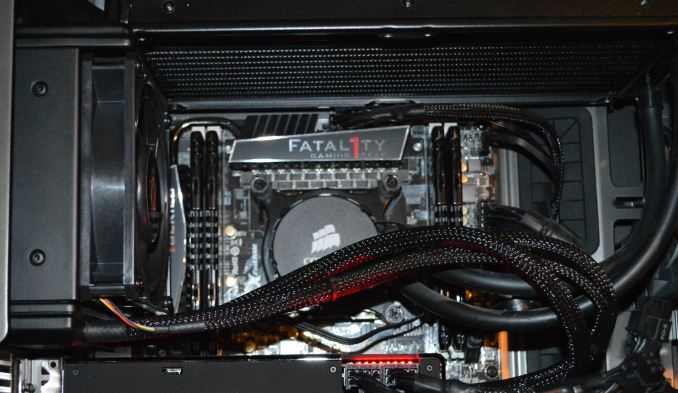The AMD Radeon R9 Fury X Review: Aiming For the Top
by Ryan Smith on July 2, 2015 11:15 AM ESTThe State of Mantle, The Drivers, & The Test
Before diving into our long-awaited benchmark results, I wanted to quickly touch upon the state of Mantle now that AMD has given us a bit more insight into what’s going on.
With the Vulkan project having inherited and extended Mantle, Mantle’s external development is at an end for AMD. AMD has already told us in the past that they are essentially taking it back inside, and will be using it as a platform for testing future API developments. Externally then AMD has now thrown all of their weight behind Vulkan and DirectX 12, telling developers that future games should use those APIs and not Mantle.
In the meantime there is the question of what happens to existing Mantle games. So far there are about half a dozen games that support the API, and for these games Mantle is the only low-level API available to them. Should Mantle disappear, then these games would no longer be able to render at such a low-level.
The situation then is that in discussing the performance results of the R9 Fury X with Mantle, AMD has confirmed that while they are not outright dropping Mantle support, they have ceased all further Mantle optimization. Of particular note, the Mantle driver has not been optimized at all for GCN 1.2, which includes not just R9 Fury X, but R9 285, R9 380, and the Carrizo APU as well. Mantle titles will probably still work on these products – and for the record we can’t get Civilization: Beyond Earth to play nicely with the R9 285 via Mantle – but performance is another matter. Mantle is essentially deprecated at this point, and while AMD isn’t going out of their way to break backwards compatibility they aren’t going to put resources into helping it either. The experiment that is Mantle has come to an end.
This will in turn impact our testing somewhat. For our 2015 benchmark suite we began using low-level APIs when available, which in the current game suite includes Battlefield 4, Dragon Age: Inquisition, and Civilization: Beyond Earth, not counting on AMD to cease optimizing Mantle quite so soon. As a result we’re in the uncomfortable position of having to backtrack on our policies some in order to not base our recommendations on stupid settings.
Starting with this review we’re going to use low-level APIs when available, and when using them makes performance sense. That means we’re not going to use Mantle in the cases where performance has clearly regressed due to a lack of optimizations, but will use it for games where it still works as expected (which essentially comes down to Civ: BE). Ultimately everything will move to Vulkan and DirectX 12, but in the meantime we will need to be more selective about where we use Mantle.
The Drivers
For the launch of the 300/Fury series, AMD has taken an unexpected direction with their drivers. The launch driver for these parts is the Catalyst 15.15 driver, AMD’s next major driver branch which includes everything from Fiji support to WDDM 2.0 support. However in launching these parts, AMD has bifurcated their drivers; the new cards get Catalyst 15.15, the old cards get Catalyst 15.6 (driver version 14.502).
Eventually AMD will bring these cards back together in a later driver release, after they have done more extensive QA against their older cards. In the meantime it’s possible to use a modified version of Catalyst 15.15 to enable support for some of these older cards, but unsigned drivers and Windows do not get along well, and it introduces other potential issues. Otherwise considering that these new drivers do include performance improvements for existing cards, we are not especially happy with the current situation. Existing Radeon owners are essentially having performance held back from them, if only temporarily. Small tomes could be written on AMD’s driver situation – they clearly don’t have the resources to do everything they’d like to at once – but this is perhaps the most difficult situation they’ve put Radeon owners in yet.
The Test
Finally, let’s talk testing. For our benchmarking we have used AMD’s Catalyst 15.15 beta drivers for the R9 Fury X, and their Catalyst 15.5 beta drivers for all other AMD cards. Meanwhile for NVIDIA cards we are on release 352.90.
From a build standpoint we’d like to remind everyone that installing a GPU radiator in our closed cased test bed does require reconfiguring the test bed slightly; a 120mm rear exhaust fan must be removed to make room for the GPU radiator.
| CPU: | Intel Core i7-4960X @ 4.2GHz |
| Motherboard: | ASRock Fatal1ty X79 Professional |
| Power Supply: | Corsair AX1200i |
| Hard Disk: | Samsung SSD 840 EVO (750GB) |
| Memory: | G.Skill RipjawZ DDR3-1866 4 x 8GB (9-10-9-26) |
| Case: | NZXT Phantom 630 Windowed Edition |
| Monitor: | Asus PQ321 |
| Video Cards: | AMD Radeon R9 Fury X AMD Radeon R9 295X2 AMD Radeon R9 290X AMD Radeon R9 285 AMD Radeon HD 7970 NVIDIA GeForce GTX Titan X NVIDIA GeForce GTX 980 Ti NVIDIA GeForce GTX 980 NVIDIA GeForce GTX 780 Ti NVIDIA GeForce GTX 680 NVIDIA GeForce GTX 580 |
| Video Drivers: | NVIDIA Release 352.90 Beta AMD Catalyst Cat 15.5 Beta (All Other AMD Cards) AMD Catalyst Cat 15.15 Beta (R9 Fury X) |
| OS: | Windows 8.1 Pro |













458 Comments
View All Comments
D. Lister - Thursday, July 2, 2015 - link
"AMD had tessellation years before nVidia, but it went unused until DX11, by which time nVidia knew AMD's capabilities and intentionally designed a way to stay ahead in tessellation. AMD's own technology being used against it only because it released it so early. HBM, I fear, will be another example of this. AMD helped to develop HBM and interposer technologies and used them first, but I bet nVidia will benefit most from them."AMD is often first at announcing features. Nvidia is often first at implementing them properly. It is clever marketing vs clever engineering. At the end of the day, one gets more customers than the other.
sabrewings - Thursday, July 2, 2015 - link
While you're right that Nvidia paid for the chips used in 980 Tis, they're still most likely not fit for Titan X use and are cut to remove the underperforming sections. Without really knowing what their GM200 yields are like, I'd be willing to be the $1000 price of the Titan X was already paying for the 980 Ti chips. So, Nvidia gets to play with binned chips to sell at $650 while AMD has to rely on fully up chips added to an expensive interposer with more expensive memory and a more expensive cooling solution to meet the same price point for performance. Nvidia definitely forced AMD into a corner here, so as I said I would say they won.Though, I don't necessarily say that AMD lost, they just make it look much harder to do what Nvidia was already doing and making bookoo cash at that. This only makes AMD's problems worse as they won't get the volume to gain marketshare and they're not hitting the margins needed to heavily reinvest in R&D for the next round.
Kutark - Friday, July 3, 2015 - link
So basically what you're saying is Nvidia is a better run company with smarter people working there.squngy - Friday, July 3, 2015 - link
"and they cost more per chip to produce than AMD's Fiji GPU."Unless AMD has a genie making it for them that's impossible.
Not only is fiji larger, it also uses a totally new technology (HBM).
JumpingJack - Saturday, July 4, 2015 - link
"AMD had tessellation years before nVidia, but it went unused until DX11, by which time nVidia knew AMD's capabilities and intentionally designed a way to stay ahead in tessellation. AMD's own technology being used against it only because it released it so early. HBM, I fear, will be another example of this. AMD helped to develop HBM and interposer technologies and used them first, but I bet nVidia will benefit most from them."AMD fanboys make it sound like AMD can actually walk on water. AMD did work with Hynix, but the magic of HBM comes in the density from die stacking, which AMD did nothing (they are no longer the actual chipmaker as you probably know). As for interposers, this is not new technology, interposers are well established techniques for condensing an array of devices into one package.
AMD deserves credit for bringing the technology to market, no doubt, but their actually IP contribution is quite small.
ianmills - Thursday, July 2, 2015 - link
Good that you are feeling better Ryan and thanks for the review :)That being said Anandtech needs keep us better informed when things come up.... The way this site handled it though is gonna lose this site readers...
Kristian Vättö - Thursday, July 2, 2015 - link
Ryan tweeted about the Fiji schedule several times and we were also open about it in the comments whenever someone asked, even though it wasn't relevant to the article in question. It's not like we were secretive about it and I think a full article of an article delay would be a little overkill.sabrewings - Thursday, July 2, 2015 - link
Those tweets are even featured on the site in the side bar. Not sure how much clearer it could get without an article about a delayed article.testbug00 - Sunday, July 5, 2015 - link
Pipeline story... Dunno title, but, for text, explain it there. Have a link to THG as owned by same company now if readers want to read a review immediately.Twitter is non-ideal.
funkforce - Monday, July 6, 2015 - link
The problem isn't only with the delays, it is that since Ryan took over as Editor in Chief I suspect his workload is too large.Because this also happened with the Nvidia GTX 960 review. He told 5-6 people (including me) for 5 weeks that it would come, and then it didn’t and he stopped responding to inquires about it.
Now in what way is that a good way to build a good relationship and trust between you and your readers?
I love Ryan's writing, this article was one of the best I've read in a long time. But not everyone is good at everything, maybe Ryan needs to focus on only GPU reviews and not running the site or whatever his other responsibilities are as Edit. in Chief.
Because the Reviews are what most ppl. come here for and what built this site. You guys are amazing, but AT never used to miss releasing articles the same day NDA was lifted in the past that I can remember. And promising things and then not delivering, sticking your head in the sand and not even apologizing isn’t a way to build up trust and uphold and strengthen the large following this site has.
I love this site, been reading it since the 1st year it came out, and that's why I care and I want you to continue and prosper.
Since a lot of ppl. can’t reed the twitter feed then what you did here: http://www.anandtech.com/show/8923/nvidia-launches...
Is the way to go if something comes up, but then you have to deliver on your promises.